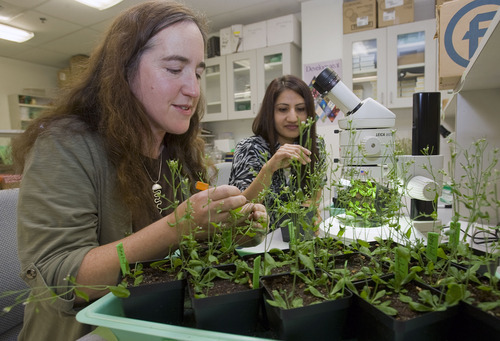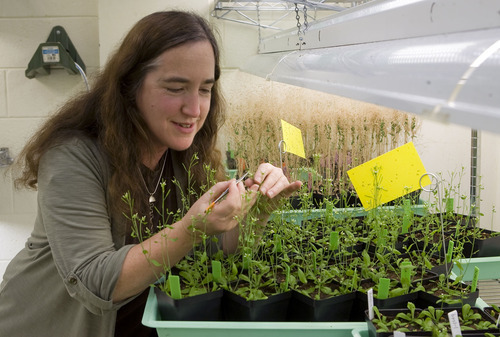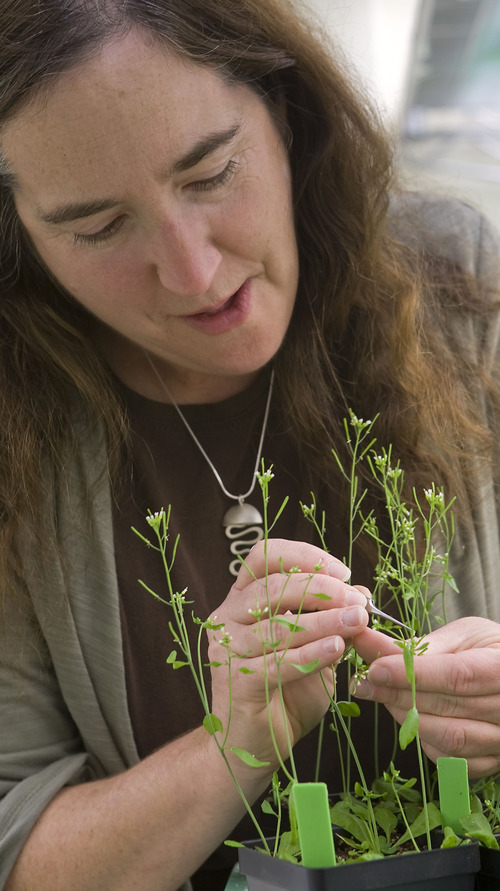This is an archived article that was published on sltrib.com in 2011, and information in the article may be outdated. It is provided only for personal research purposes and may not be reprinted.
Plants communicate. Maybe not to us or each other, but definitely to their own parts, relaying critical information the way our endocrinological systems circulate hormones.
This communication helps plants survive tough conditions. But it also inhibits growth, posing real challenges to food-production systems that want to coax crops out of plants even when they're stressed, according to University of Utah biologist Leslie Sieburth, who is looking for answers.
Her quest is to unlock the mechanism by which plants' roots tell leaves, "Hey, stop growing," when they are assaulted by pathogens, drought and other environmental pressures. Keeping crop plants productive while preserving their resilience will be crucial to supporting an expanding world population, expected to hit 9 billion by 2050, Sieburth says. Just a few weeks ago, it reached 7 billion.
"How will we feed 2 billion more people? Already we don't feed everyone effectively. Add to that climate change, that makes it more challenging," said U. science dean Pierre Sokolsky in introducing Sieburth to a recent gathering with Salt Lake City's business community.
Global warming is expect to result in more drought, pests that survive winters and an influx of pathogens, all conditions that will reduce cropland productivity. In the 1950s and '60s, the Green Revolution helped expand crop yields through fertilizers, pesticides and plant breeding. World population soon doubled, but yields have plateaued.
"Why can't we just keep that revolution going?" Sieburth said. Bugs have evolved resistance to pesticides, and fertilizer ingredients are scarce.
"Phosphorous is running out. Other costs are skyrocketing. Traditional plant breeding is very slow," Sieburth said. "We are losing farmland. Will we start growing food in our national parks? I would hate to see that happen."
One solution is a new Green Revolution that is smarter than the last one, she said.
"We need crops that survive in an uncertain climate. They will be genetically modified based on knowledge of molecular pathways," she said.
Leaves harvest solar radiation and convert it to sugar through photosynthesis, so processes that inhibit leaf growth depress yields. The revolution Sieburth envisions would interrupt these processes.
Several years ago Sieburth and her collaborators discovered the gene that enables signaling between roots and leaves in most land plants. Now they are trying to identify the molecule that carries the signal through the plant's vascular system and the protein that serves as a receptor on the cell walls in the leaves.
The idea is to "engineer" plants to keep their environmental triggers from turning off growth.
Prior research has determined that plant growth slows when only a single root is exposed to dry soil. Remove the dry root and growth rebounds.
"It triggers molecular events downstream that stops cells from dividing. We want to find out what that is," Sieburth said. Her collaborators include University of California Riverside geneticist Julia Bailey-Serres, a U. graduate, and her brother, Temple University chemist Scott Sieburth. The work is funded by the National Science Foundation and the U.S. Department of Agriculture.
Her experiments are conducted on thale cress, an ideal plant for use in labs because it is a compact self-pollinator that produces lots of seeds and its entire genome is known. The research got a big boost when Sieburth happened upon a mutant strain that overproduces the triggering molecule responsible for diminished growth. When they graft a mutant root to healthy plants, leaf growth stalls.
The team has determined the triggering molecule can pass through an agar block and is hoping to nail down its identity through bioassays.
"We are on the trail to finding it. When we find it we can find what is the stimulus," Sieburth said. But that's only half the story. Equally crucial is identifying the molecule's receptors that sit on the cell walls. There are 610 possible proteins, but Sieburth's team has narrowed the search to a handful of likely candidates.
If scientists can prevent these proteins from interacting with the signaling molecule, they might be able to figure out a way to keep crops plants both productive and healthy even when soils are dry and microscopic disease vectors attack.
Leslie Sieburth
This University of Utah biology professor is exploring how plant roots signal to leaves, telling them to slow growth in response to drought and pathogens. Sieburth believes disrupting these signals can spur a second Green Revolution and save agriculture from climate change.







